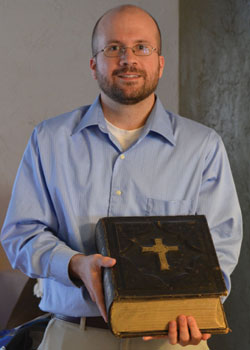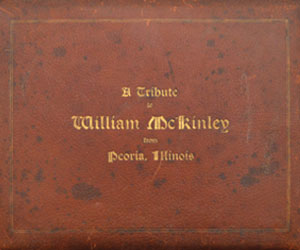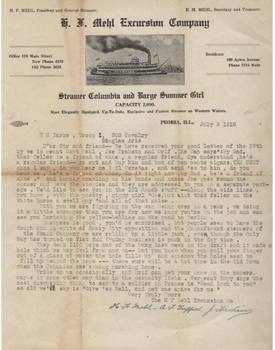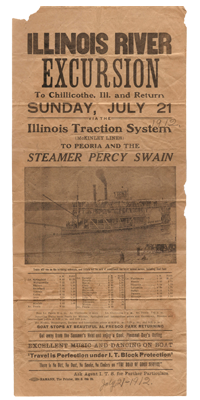
PeoriaHistory.com is dedicated to free access of privately held documents and artifacts of historical significance to the central Illinois region. The site was created by Phillip Mott in the spring of 2018 to share items from his personal collection. Originally from the small town of Staunton, Illinois, Mott has lived in the Peoria area since graduating from Western Illinois University in 2004. He and his wife, Allison, are both teachers—she works at Riverview Grade School in East Peoria, and he works in the Peoria Heights School District. They have two children: Eliza, six, and Leo, who turns two in October.
Believing that historic and cultural artifacts should be shared and not hoarded, Mott began sharing his finds on social media, then decided a dedicated website would make his collection more accessible. Using an open-source software platform, he has left open the door for other like-minded individuals or organizations to contribute digitized items or possibly coordinate efforts in a more substantial way.
When did you start collecting historic Peoria items, and what sparked your interest?
I think a culmination of events and interests have fostered my unusual hobby. At a very young age, my mother and grandmother took me to antique stores searching for “treasures.” Though my definition of “treasure” has changed over the years, I have always enjoyed hunting for hard-to-find items. My specific interest in Peoria history can be directly attributed to Allison. One of her favorite activities is driving around town to look at the old, historic homes. We have also enjoyed the various Peoria Historical Society tours. I have shared in her distress at the slow deterioration and occasional demolition of many of these historic sites. Financially, we are unable to save these homes, but there are other ways to preserve history...

My first purchase of Peoria history happens to be my favorite artifact. I stumbled across an auction for a book titled A Tribute to William McKinley from Peoria, Illinois. My initial thought was that perhaps it was some sort of condolence book given to family after his death, but then I recalled that McKinley had visited Peoria once before. I started to dig and found that it was indeed a gift presented to the President of the United States in the Joseph B. Greenhut mansion after his dedication of the Soldiers and Sailors Monument. Needless to say, I had to have this book.
There are 1,026 signatures of Peorians great and small—each with their own story to tell. Henry Detweiller, Lydia Bradley, Joseph B. Greenhut, John Lancaster Spalding and many more signed it. This one item was held by the president, an Olympian, politicians, whiskey barons, veterans, teachers, students, police officers, grocers, bankers, inventors and sadly, a grieving mother, whose signature stood out more than any other: Alwyn Forsythe Milligan’s mother, Kate, wrote his name below hers. He was born in 1899, but doesn’t seem to have made it to 1900. As sad as it was to discover this small tribute, I’m sure she would be happy to know that his name was being spoken over 100 years later.
What led you to start PeoriaHistory.com?
After I finished researching the McKinley book, I began hunting down more artifacts and decided to share my finds online. I haven’t really shared much of the stories behind the items, but generally put them out there for other people to investigate on their own. Knowing there might be more likeminded people, I opted to use Omeka [a content management system for online digital collections] so others can submit their images to the site and potentially it might grow into a larger collaborative effort between collectors and possibly organizations. It’s my hobby right now, but maybe it’ll one day become something more.
How do you find and acquire these historic artifacts? What is your selection process?
I would go broke buying everything I see in antique stores, yard sales, coin shops, personal collections or on the internet. I mostly look for letters, documents and other paper items with a story that I personally can appreciate. I’ll eventually share everything I have, but it is sometimes hard to find the time between work and family.

Why do you believe public access to historical documents is so critical?
I’m an amateur genealogist who has benefited from the generosity of others. I was given the family Bible of the first Mott to come to America. He and I share the same first and last name. It would be such a shame if it would have been locked away in his collection, never to be seen by the family it belongs to. I want others to be able to see their family’s history.
What are some of the most unusual artifacts you’ve found?
I have already told you about the McKinley book, but there are so many more. There is a letter written by the Mehl Excursion Company two days before the sinking of the Columbia, receipts for the construction of part of “Camp Peoria” during the Civil War, a sculpture carved in marble by Fritz Triebel, letters regarding the construction of the first railroad in Peoria, a contract for a loan that in great part caused the failure and run on a bank, the signature of a submarine captain, brochures, tickets, contracts, etc.
One of my more unusual finds was a letter from one distiller to another discussing matters of the occult. Another of my favorite items is a letter written by a former boxer who shares that he was forced to throw a fight in order to give his children a good Christmas.

How much background research do you conduct on the various items you post?
It takes a great deal of time to make sure I know what I have before I post an item. A combination of Google Books, newspapers.com, ancestry.com and archive.org are usually all the resources I need; however, a trip to the library is often necessary. The people and resources at the Local History and Genealogy Department at the Peoria Public Library and the Special Collections Center at Bradley University have been particularly helpful.
Who are some of your active contributors?
With one exception from the Princeville Heritage Museum, everything on the website belongs to me. Maybe others will one day contribute.
Do you get a lot of feedback from the public about your finds?
There are often many “That was my grandfather” or “My grandmother used to work there…” I’ll occasionally run across a citation using information from peoriahistory.com. This encourages me to slow down and double-check accuracy.
Do you have a collection of items you haven’t scanned yet? Any major projects on the horizon?
I would estimate that I have about 25 percent of my collection scanned. There are a number of significant projects that I’m looking forward to tackling. In addition to documents, pins and ribbons, I have eight books that will require a momentous effort to research and transcribe. Of those, I think I’m most excited to dive into the train, riverboat and coach record books of H.G. Farrell Co. from the early 1850s. I’m also eager to start work on the 1856 ledger of William Dobbins containing accounts from his distillery and personal life. PM
Check out Mott’s local history collection at peoriahistory.com.
- Log in to post comments

